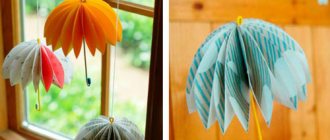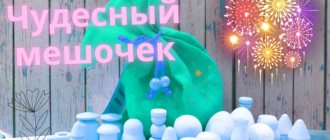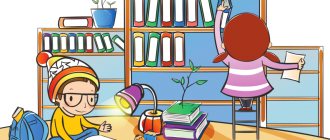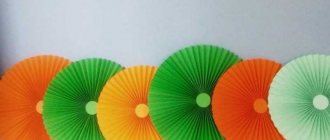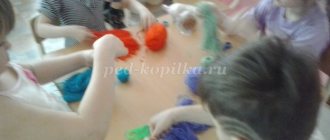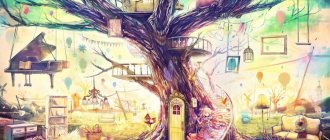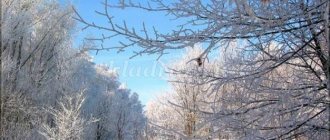Summary of an open lesson on manual labor for older children “Surprise Toy”
Objectives: -improve the ability to work with paper: bend the sheet in different directions, smooth the folds, cut along the folds. - develop creative imagination and artistic taste. — cultivate accuracy, teach how to treat finished products with care. Goal: - consolidate acquired skills in creative transformation of objects. Materials: colored paper, scissors, glue, napkins, Pinocchio toy, audio recording with the song 'Bu-ra-ti-no!' (from the movie 'The Adventures of Pinocchio'), tray, wonderful bag with surprises. Preliminary work: reading A. Tolstoy’s fairy tale “The Golden Key or the Adventures of Pinocchio.”
Progress of the lesson.
Children, together with the teacher, enter the group. The guys greet the guests. Voss: - Guys, do you like surprises? Children: Yes. Voss: -I really like surprises. There is one fairy-tale hero who cannot live without surprises. Guess the riddle. My father has a strange boy, unusual, wooden. He is looking for a golden key on land and under water. He sticks his long nose everywhere. Who is this? Children: Pinocchio. Question: Pinocchio wanted to make a gift for his friends from the fairy tale in which he lives, but he didn’t succeed. Oh, Pinocchio, where are you? Oh, here he is, why are you hiding? (Pinocchio whispers something in his ear, the teacher nods) Voss: Guys, Pinocchio asks you to help him make surprises for his friends. Do you agree? Children: Yes. Voss: (addresses the toy Pinocchio) -Who are your friends? (Pinocchio is silent). Voss: - Guys, help. What are the names of Buratino's friends? Children: -Malvina, Pierrot, Harlequin, poodle Artemon, tortoise Tortila. Voss: Which other fairy-tale characters do you know? Children: - Karabas Barabas, talking cricket, dad Carlo, Giuseppe, cat Basilio, fox Alice, Duremar, rat Shushara. Voss: (shows a box with a surprise) - This is the surprise we will help you make Pinocchio. The teacher places the Pinocchio toy at the table with the children. Vos-l: (Explanation of work) - And it’s done like this. First you need to make a box: take a rectangular sheet, 2 stripes are drawn on it, you need to bend it along the stripes. We bent it in strips, turned it around, put the narrow side towards us and bend corner to corner in half away from us and again in half away from us. Let's expand. In the top row we got 3 squares, cut out the outer ones along the fold line, leaving 1 square - this is the lid of the box. We make 2 cuts from the lid of the box and 2 more cuts at the bottom opposite the first ones. Our box is almost ready, all that remains is to glue it together. I spread glue on the 2 outer squares near the lid and the 2 outermost squares. We do it like this: bend over, spread, bend over, spread, glue one, then the other, put on top of each other, bend the bottom squares, spread, glue everything in the middle of the box, you get a box. Voss: - Pinocchio, do you understand how to make a box? Aren't you tired? And now a surprise, we have a cheerful face from the box. The face is held on the paper by a folded spring. Take 2 strips of paper. Glue the 2 ends together and bend one or the other strip to the end. The result is a two-color spring. Glue a spring to the bottom of the box, and glue a cheerful face to the top tip. Look what happened... Voss: - And now the guys will do it. Guys, tell me, do we make a box or a spring first? Children: -A box, then a spring. (Explaining to children how they will do the work). Voss: -Pinocchio is tired, let's stretch his arms and legs.
Physical education minute:
Pinocchio stretched, 1 - bent over, 2 - straightened up, spread his arms to the sides, Apparently he didn’t find the key. To get the key for him, you have to stand on your toes. Stand tighter than Pinocchio, Here is the golden key. Voss: - Sit down guys. Well done, you need to stretch your fingers.
Finger gymnastics:
Katina's dolls are sitting in a row on a large sofa. Two bears, Pinocchio, and cheerful Cipollino, And a kitten and a baby elephant. One, 2, 3, 4, 5 Let’s help our Katya count all the toys. Voss: - Now you will make the surprise yourself. Remember to use scissors carefully. And you Pinocchio, sit and look carefully, the guys will work for a long time, but diligently. The guys make surprise boxes and place them on a tray. Voss: - Thanks, guys! They helped me out, now I will give gifts to my friends, and leave surprises for you as a gift. (wooden eggs for painting). Pinocchio leaves.
Author: Kozaeva Svetlana Aleksandrovna, teacher, MBDOU kindergarten No. 55 “Cornflower”, Murmansk, Russia
The article is published in the author's edition
Summary of joint activities in manual labor “Repairing books”
Joint activities on manual labor in preparatory group No. 22
"Book Repair"
Educator: Yagfarova A.R.
Goal: to consolidate the rules for handling a book.
Tasks:
- Educational: to develop children’s ability to repair books;
- Developmental: consolidate the ability to bend a strip in half, develop fine motor skills of the hands;
- Educational: cultivate friendly relationships between children, the desire to work together, and find common interests.
Materials: children's books, strips of colored paper, scissors, glue, use of ICT tools (presentation).
Progress of joint activities
The children stand in a semicircle. To the side there are tables with tools and materials for manual labor.
Educator: One, two, three, four, five - stand in a circle to play. A new day has come. I will smile at you, and you will smile at me and the guests. Take a deep breath through your nose and breathe in the freshness, kindness, and beauty of the coming day.
Educator: I want to tell you a riddle, and when you guess it, you will find out what we will talk about in class.
Not a bush, but with leaves,
Not a shirt, but sewn,
Not a man, but a storyteller,
What is this? (book)
Educator: correct,
we'll talk about books today.
Tell me, what are books for?
(children’s answers: gain new knowledge, learn new interesting things; you can travel with a book; meet fairy-tale characters, look at interesting, colorful illustrations; books introduce us to good and evil people, good and bad deeds)
Educator: do you know what parts the book consists of?
(Children's answers)
Educator: The front side of the book and the last one is called the cover. A book has a spine where all the pages are sewn or glued together.
Children, where have we seen so many books?
(Children's answers)
Educator: What books? About what?
(Children's answers: books are thick and thin, large and small, fairy tales, stories, etc.)
Educator: Children, you remember, the librarian told us that books live for 10-15 years. Why do they live so long?
(Children's answers: because they are looked after, cleaned and treated correctly).
Educator: what rules for handling a book do you know?
Rules:
- Don't draw in books!
- Don't throw books away!
- Don't tear pages out of books!
- Don't get books wet!
- Do not wrinkle the pages or page corners of books!
Educator: There is a boy in the younger group, Grisha, who doesn’t know how to handle a book. Therefore, his books begin to get sick, grow old and lose their beautiful appearance. Listen to the poem by S.Ya. Marshak, what books did this boy have (reading a poem).
At Skvortsov's Grishka,
Once upon a time there were books -
Lesson notes for the senior group of preschool educational institutions. Manual labor
Summary of the organization of labor activity (manual labor) in the senior group
Title of work : Summary of labor activity (manual labor) in the senior group in accordance with the Federal State Educational area : Social and communicative development. Program development : Involve children in design creativity, through which decorations for the walking area and birthday gifts for peers will be made. Develop skills in working with cardboard and colored paper when making birds and in weaving bracelets and jump ropes from rubber bands. Improve skills in gluing cardboard onto a sheet of colored paper, folding paper diagonally like an accordion, weaving on a machine and slingshot in different ways. Develop image perception, color perception when choosing the color of rubber bands when combining them, paper when combining the color of a bird and wings; recreating and creative imagination, hand motor skills. Foster love for kindergarten by creating decorations for it; peers of the group, creating gifts for them. Friendly relations when performing work, the ability to work in a team, to help comrades. Equipment: Cardboard bird shapes, colored paper, paste, oilcloth, brushes, paste, scissors, twine; sets with elastic bands, hooks and weaving machines. Preliminary work : Examination of decorations for kindergarten areas, cutting out birds along the contour, learning to weave from rubber bands. Vocabulary activation: Weaving, hook, loop, loom, cardboard decoration, designers. Motivation: 1. Contribute the painting “Waiting for the Birds” Conversation about the content of the painting and what awaits us in the near future. Children answer the teacher’s questions, note what needs to be done in order to attract birds to their site, and how to please their peers on the day birth.
2. I propose to consider the material from which children’s crafts will be made. 3. I invite the children to divide into subgroups and choose a senior assistant in each subgroup. The children are divided into subgroups and choose a senior assistant. Subgroup 1, in collaboration with the teacher, makes birds to decorate the area. Subgroup 2 independently weaves bracelets from rubber bands. Main part:
The teacher gives instructions for the practical activities of children and directs the work of children in subgroups: 1 demonstrates folding paper with an “Accordion” and methods of weaving with rubber bands.
2 helps with difficulties and gives verbal and practical instructions when children perform work. After listening to the task and discussing how to complete it with the teacher, the children begin to complete the work; if necessary, they turn to the teacher for help. Senior assistants in subgroups help peers when necessary. Subgroup 2 independently chooses the type of weaving and works in collaboration with peers. The teacher's leadership of this subgroup is indirect. Health-saving technologies: 1. I suggest performing the finger game “Friendship” before completing work and after completing work. 2. Gymnastics for the eyes after completing work 3. Offer to perform dance movements to music. Reflection: Reviewing the work, noting why and for whom it was done
The area was decorated with these birds, and now they will greet feathered guests. And the bracelets were presented to the guests who attended this event.
We recommend watching:
Summary of educational activities in the senior group “Journey to a Fairy Tale” Summary of a mathematics lesson for children of the senior orthopedic group Summary of educational and gaming activities in the senior group in the section of the “Childhood” program Synopsis of educational activities for the perception of music in the senior group of kindergarten
Similar articles:
Lesson in the senior group of kindergarten on the topic of February 23
Lesson notes for children of senior preschool age. Topic: Invisible air
Summary of organized educational activities for children of the senior group
Notes for mathematics classes in the senior group
Lesson summary on the topic “Reserve” in the senior group
Summary of the organization of manual labor in the senior group of kindergarten. Topic: “Gluing up books”
Summary of the organization of manual labor in the senior group of preschool educational institutions
Topic: “Gluing up books”
Educator: Tishchenko T.N.
Goal: Formation of readiness for joint activities with peers.
Objectives: To introduce the procedure for gluing a book, to teach them to negotiate among themselves, distributing individual labor operations. To cultivate hard work, a desire to help, and a caring attitude toward books.
Equipment: Books, paper, colored paper, scissors, glue, brushes, napkins, oilcloths, pencil.
Vocabulary work: “Consultant”, “conveyor”.
Preliminary work: Conversation about people of different professions creating a book; introduction to the new word “typography”; reading poetry - B. Zakhoder “The Bookbinder”, S. Marshak “How your book was printed”, V. Kashinkin “The First Book”.
Progress of the lesson.
- Guys, yesterday we were looking through the books in our library and noticed that some were in need of repair. There were few of us and we didn’t have time to repair everything. I propose to open a book repair workshop today. You will all be masters, and I will be the main consultant. Do you know what this means?
- I will give you the necessary consultations, or advice, tips when doing the work. To complete a large amount of work, I suggest setting up a working conveyor. Do you know how it is?
- This is when the entire work process is divided into parts. And everyone does only their job, one after another. Now we will distribute who will do what.
- Who will inspect the books and cut out patches from paper?
Katya and Christina are attentive, work well with scissors, and know how to choose the right color of paper. I think you can do the job. Get your seats ready for work. (Children take a set of colored paper, white paper, a simple pencil, scissors, pre-selected books for repair)
- Marina will carefully spread glue on the strips of paper prepared by the girls and pass them on. Take everything you need for work.
(glue, brush, oilcloth, napkin)
—Who will complete the work by putting a patch on the book? Well, Zhenya takes her work responsibly and diligently. Let's trust her with the final stage.
- Is everyone ready? The workshop is open!
(Children do the work, the teacher provides individual assistance.)
- Look how much fun the books have become! Let's count how many books we have glued. A lot of. Could I glue that much on my own? (No!)
“If we do all the work in unison, together, then everything will be fine in our group.” Thank you very much to all my masters!
Publication address:
Manual labor classes
Materials found: 21 Shown: 1 — 10
An educational activity with elements of work activity. “A hut is not red in its corners, but red in its pies”
Cognitive lesson with elements of work activity in the senior group. “A hut is not red in its corners - it is red in its pies” Goal: To introduce children to ancient household items and their purpose. Give children knowledge about what yeast is and...
Clown is a cane puppet. Joint activity with children and their parents.
Topic: “Miracle theater in the country” Goal: Based on the joint activities of children and their parents, create a theatrical doll “Clown”. Objectives: Make it clear...
Integrated lesson in manual labor and music together with parents in the senior group. Autumn
Integrated lesson on manual labor and music together with parents in the senior group Topic: In the natural world. Autumn. Goal: to teach children to feel the specificity of natural material, to see the palette of its colors, shapes, textures and...
Open lesson in the middle group. Snowdrop Day
Summary of joint activities using various types of games with children of middle preschool age topic: “Snowdrop Day.” Goal: To stimulate children's desire to create snowdrop flowers using paper origami techniques, ...
Methodological development of classes for children in the preparatory school group on the section “Manual labor”
Methodological development of a lesson for children in a preparatory group for school in the section “Manual Labor” Topic: Information and application “Military Field Post” Case form: educational lesson Purpose: To contribute to the formation...
FGT didactic game “Let’s wash the doll’s dress.” 2. ml. group
Didactic game-imitation “Let’s wash the doll’s dress” in the second junior group Type of activity: integrated (communicative, labor) Form of implementation: small group (3-4 children) Educational areas: “Communication”, ...
Manual labor lesson: “Little Cowardly Little Bunny”
Program content: Learn to fold the “basic shape” of origami - double triangle; make a tree of three squares of different sizes, arranging them in descending order. Teach children to make animals using the technique...
Manual labor lesson: “Polar bears”
Program tasks: -Learn to perform three-dimensional images using cotton wool; — Expanding children’s knowledge about the polar bear; — Develop skills in working with glue, scissors, paper; work with the template. - Develop spatial thinking...
Summary of a lesson in manual labor (origami): “Flowers for Mom”
Summary of a lesson on manual labor (origami) (preparatory group) “Flowers for Mom” Teacher, MDOU D/s No. 15, Koshkina N. A, 2012 Technology: collective (CSR) Goals: Continue to introduce children to Japanese...
Lesson “Luntik visiting the guys”
Manual labor lesson in the middle group “Luntik visiting the guys.”
Goal: To develop children's creative activity and imagination using phytodesign techniques. Objectives: 1. Teach a holistic perception of the subject. 2. Develop... Pages:
All sections
